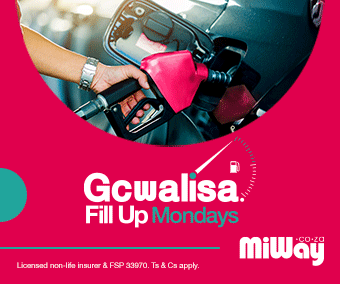Nutshell:
- Badly maintained tyres and rims cause carnage on SA’s roads.
- During the 2018 Easter Weekend, 1698 drivers were arrested for driving with worn tyres.
- Tyre failure contributes to about 20% of accidents involving minibuses.
- A worn tyre reduces the handling ability of a passenger car by around 33%.
- 18 tyre and wheel check tips that every motorist should do.
Badly maintained tyres and rims are one of the leading causes of car accidents in South Africa and, with the April long weekend approaching, Auto & General Insurance urges motorists to get into the habit of regular inspections, tyre and rim maintenance, as well as making well-informed decisions when purchasing tyres.
The Department of Transport reported that, during the 2018 Easter Weekend, an astounding 1698 drivers were arrested for driving vehicles with worn tyres. According to the CSIR, tyre failure contributes to about 20% of accidents involving minibuses.
“Every year, worn and damaged tyres cause carnage on our roads. According to recent research by the AAA, a worn tyre reduces the handling ability of a passenger car by 33% – a recipe for disaster that could very well cost you and your loves ones your lives”, says Ricardo Coetzee, Head of Auto & General Insurance.
Auto & General Insurance provides some tips for making sure that your tyres and wheels are in tiptop shape:
Tyres
- Spec inspection: Make sure that the tyres of your vehicle meet the size, speed and load rating requirements for your vehicle and their intended use.
- Root in research: Do a thorough research when buying a new set of tyres – making sure that you find a good all-rounder tyre that offers low rolling resistance and good fuel consumption, whilst still providing enough grip, aquaplaning resistance and stopping power in all weather conditions. A good port of call is to visit a couple of reputable dealers and ask for a recommendation on which tyre best suits your requirements and budget.
- Read the dots: When purchasing new tyres, look out for the tyres’ 4-digit DOT code, printed on the wall of the tyre. A dot code of 3718, for example, means that the tyre was manufactured in the 37th week of 2018. A good guideline is that you shouldn’t purchase tyres more than 6 years past their date and tyres that are more than 10 years past their date of manufacture should be replaced immediately. If your tyres only have a 3-digit DOT code, it means that they were manufactured before the year 2000 – replace them urgently.
- Used and bruised: Refrain from buying second-hand tyres, especially when they have been illegally “regrooved”.
- Fill-up check: When you fill up with fuel, check the inflation pressure in all your tyres with a reliable pressure gauge. Don’t simply rely on “eying it”, as tyres that are well below-recommended pressures could still appear sufficiently inflated.
- Cold is cool: Only check tyre pressure when the tyres are cold. If you deflate a hot tyre to the recommended pressure, it may become under-inflated, leading to a heat build-up and increase the risk of a blowout.
- Pressure perfect: Inflate tyres to the recommended pressure in your owner’s manual or the tyre inflation guide decal in the glove box or door pillar. Should you have aftermarket rims and/or tyres fitted to your vehicle, check correct pressures with the installer, as they probably differ from standard pressures.
- Surface scan: If there are any sharp objects lodged in the tyre, cuts, bulges or bruises on the tyre’s surface or walls, it’s a serious reason for concern. A bulge on the tyre’s surface is caused by internal damage and puts you at high risk of a blowout. If a tyre’s sidewall is damaged, replace it immediately.
- Wary of wear: If a tyre is wearing more in the middle than on the shoulders, it’s probably over-inflated. If it’s wearing more on the shoulders, then it’s likely to be under-inflated. Uneven wear may also indicate a worn steering or suspension component, an over or under inflated tyre or bad wheel alignment and/ or balancing.
- Eye on trends: Look out for unusual trends. For instance, if a tyre loses pressure faster than the others, it could be a slow puncture which can lead to a blowout.
- Tread carefully: Ensure that each tyre has adequate tread. The South African legal limit is 1mm of tread, but anything below 3mm limits the tyre’s ability to function effectively. Replace tyres if they’re worn down to the wear bars on the tread.
- Cap it: Always check that all valves on your vehicle’s tyres have valve caps, as they prevent small objects from getting into the valve and causing a leak.
- Tire retirement: If a tyre has been in service for more than 5 years, it should be regularly checked for cracks and replaced no later than the 6-year mark.
- Beware the spare: Remember to perform the same checks that you perform on the tyres on your vehicle, on the spare, and be prepared to replace a rarely used or unused spare if it’s exceeded its lifespan. Also, make sure that you have the correct jack and other tools to remove a damaged wheel and tyre.
Wheels
- Keep it tight: Ensure that all the wheels are securely fastened and that the correct specification and quality of nuts and bolts are used. Make sure to check every nut and bolt, as a single failure could lead to failure of the entire system. Beware of overtightening these parts, as this, too, could lead to thread failure and disaster.
- Rim right: Make sure that the rims fit the specification for your car and that you have suitable tyres fitted for the specific size of the rim. Ensure that rims aren’t cracked or bent. Even minor defects could lead to anything from insufficient sealing between the tyre and rim and a loss of tyre pressure, to catastrophic failure of the rim itself.
- Look for a leak: The wheel itself must be checked inside and out for things like grease, oil or brake fluid leaking which could indicate a problem with the wheel bearing, brakes or CV joint.
- Balance act: Make sure to have the wheel balancing and alignment checked. Misaligned and improperly balanced wheels could cause anything from an increase in fuel consumption to uneven tyre wear and blowouts.
For the times when disaster strikes, despite your best preventative efforts, Coetzee suggests investing in insurance products like Auto & General’s Tyre & Rim Guard – a cost-effective solution which allows you to claim for accidental damage to your vehicle’s tyres and rims.


























